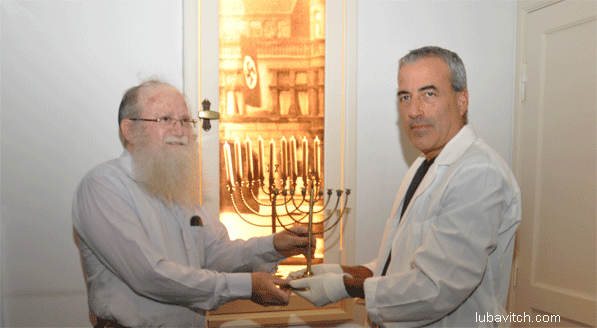(lubavitch.com— Reposted on December 19, 2017) It was the eighth night of Chanukah in Kiel, Germany, a small town with a Jewish population of 500. That year, 1931, the last night Chanukah fell on Friday evening, and Rabbi Akiva Boruch Posner, spiritual leader of the town was hurrying to light the Menorah before the Shabbat set in.
Directly across the Posner’s home stood the Nazi headquarters in Kiel, displaying the dreaded Nazi Party flag in the cold December night. With the eight lights of the Menorah glowing brightly in her window, Rabbi Posner’s wife, Rachel, snapped a photo of the Menorah and captured the Nazi building and flag in the background. She wrote a few lines in German on the back of the photo.
“Chanukah, 5692. ‘Judea dies’, thus says the banner. ‘Judea will live forever’, thus respond the lights.”
“The photo went public after a local museum came by to take a photo, and the press carried the story,” says Rachel’s grandson Yehudah Mansbuch, who lives today in Beit Shemesh, Israel. “My grandfather fled Germany in 1933, and moved to Israel. His community came to the train station to see him off, and before departed he urged his people to flee Germany while there’s still time.”
The couple’s prescience saved an entire community; only eight of the five hundred Jews perished in the Holocaust, with the rest fleeing before the systematic slaughter began. “My grandmother wrote that inscription a year and a half before the Nazi Party gained power, Mansbuch said, “but she knew what was coming, and knew that they would never succeed in dispelling the lights of her Menorah.”
Yeuhudah Mansbuch donated the Menorah to Yad Vashem, but kept the original photo. Every Chanukah, he takes his piece of history back home, and his son, who was named for his great-grandfather lights the Menorah. His son serves in the IDF, an army with a Menorah for an emblem.
Not all Jewish families in Europe displayed their Menorahs so openly. Until recently, Chanukah was mostly a kitchen-table affair; the lights were a provocation to hostile neighbors in many communities in Europe, where Jews lived under the constant shadow of persecution and oppression. To compound the problem, Chanukah usually coincided with Xmas, an especially threatening time for the Jewish people.
Today, Mansbuch agrees that Chabad representatives who host public menorah lightings in public spaces the world over are ensuring that Judea will live.
In Gothenberg, Sweden Rabbi Alexander Namdar hosted a public Menorah lighting last Thursday for a crowd of 700, in what weather experts claim is the coldest weather for early December in the last century. He insists that he does not confront anti-Semitism, but focuses on positive ways to illuminate the darkness instead.
“Chasidic thought teaches us that darkness is really only a lack of light. Simply add more light, and the darkness is dispelled.”
As long it can hold eight lights, the Menorah is open to design interpretation. In many countries, Chabad reps are finding creative ways to keep the flame of the Menorah burning. Rabbi Benyamin Wolff hired an ice carver for a ‘Chanukah on Ice’ community event last Thursday in Helsinki, Finland, where kids won’t need lessons before hitting the rink.
“Ice skating is part of the culture in Helsinki. Everyone knows how to skate here,” explains Rabbi Wolff. “The ice menorah was a something that fits with the culture and brings the message of Chanukah to the kids in a very real way.”
In downtown Vancouver, Rabbi Benyomin Bitton hired a local chef to mold a Menorah out of chocolate, which will be lit on Sunday in the presence of some 300 guests. Over one meter tall and made out of 125 kilos of kosher chocolate, Bitton says the kids will get to nibble the Menorah afterwards, “conveying the message of Chanukah in a sweet way.”
Rabbi Odom Brandman, Chabad representative in Buckhurst Hill, Essex, a small town near London has a history of creating whimsical, playfully designed Menorahs. Having made Menorahs out of cans and whiskey bottles in the past, this year’s Menorah is comprised of 500 cell phones and stands 10 feet tall, to be lit on Sunday with 150 expected to attend.
It’s important, Brandman says, “to keep the Menorah’s message alive by keeping it exciting and fun.”
Today as yesterday, the illuminated Menorah standing tall in thousands of landmarks around the world seems to declare that despite the uncertainty and the evil that lurk, despite the threats against Israel and the Jewish people, indeed, “Judea will live forever.”

Be the first to write a comment.